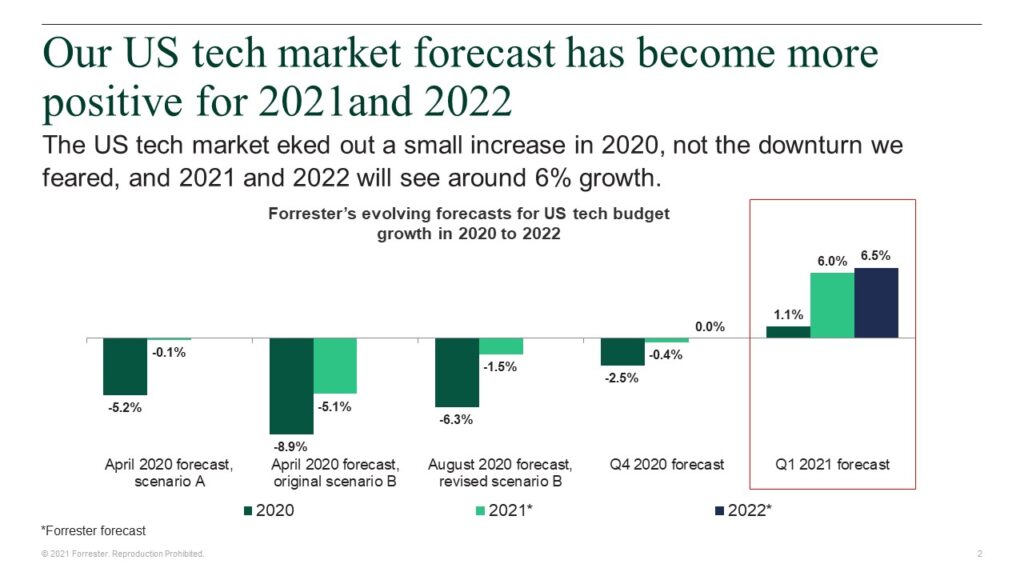The $1.9 Trillion American Rescue Plan Seals The Deal For 6% US Tech Market Growth In 2021
On March 11, 2021, President Biden signed the $1.85 trillion coronavirus relief act, officially called the American Rescue Plan. This fiscal boost — coming on top of the $900 billion relief bill adopted in January 2021, the prospect of most American adults getting vaccinated by June, and the $1.6 billion increase in personal savings in 2020 — sets the stage for a strong economic recovery in 2021 and 2022. The US tech market will directly benefit from a US economy that is now likely to grow by over 5% in 2021. Our revised forecast for the US tech market (which will be published in coming weeks) predicts 6% growth in business and government spending on tech goods, software, services, and staff in 2021 and 6.5% growth in 2022.
This is a dramatic improvement from our December 2020 US tech market report (“US Tech Market Outlook For 2021: After The Election“). One reason for the brighter outlook is that US tech purchases suffered much less in 2020 than we had feared would be the case a year ago. Final data for Q4 2020 on business and government investment in computer equipment, communications equipment and software, and on spending on tech consulting, tech outsourcing, and telecom services showed that the cutbacks in Q2 and Q3 had mostly been reversed by the end of 2020. As a result, the US tech market actually grew by 1.1% in 2020 — which is quite an improvement from the -5% to -9% drops that we expected in April 2020.

Here are the three key forecasting lessons we learned in 2020, which we will use to improve our 2021 forecast:
- Early, massive, and continuous fiscal and monetary actions can mitigate the downturn and fuel the recovery. The Federal Reserve took unprecedented steps to enable US businesses to borrow at low cost to continue to operate despite drops in revenue. Congress adopted and President Trump signed three major bills to provide trillions of dollars of financial relief to unemployed workers and stressed businesses. These actions did not prevent 20 million Americans losing their jobs in April and May of 2020 or an 11% drop in consumer spending in Q2 2020. But they did set a floor under the downturn, which allowed economic activity to resume faster than many had feared. The Biden Administration has learned the lesson from the 2009 downturn that going big on fiscal policy is better than going small. In particular, the latest economic stimulus provides funding for state and local governments and lower-income families. These parts of the new bill will help sustain the economic expansion into 2022, rather than petering out, as would have been the case otherwise.
- US tech spending skews heavily to white-collar, office-based industries that redefined their work and muscled through the pandemic. The government-mandated shutdowns and restrictions on business and the consumer pullback from in-person shopping and partying hit the travel, leisure, and entertainment industries very hard, but they had much less of an impact on industries that could continue to operate remotely. It turns out that those latter industries — financial services, insurance, media and information, professional services, government, and high-tech — represent three-quarters of US tech spending. The travel, leisure, and entertainment industries make up less than 5%. As such, tech spending was much more resilient to the downturn and bounced back faster than expected.
- CIOs and tech departments are, in fact, highly resilient. When the COVID-19 pandemic hit and most business offices closed down, tech departments quickly put in place systems to allow workers to work from home and took advantage of existing cloud applications that enabled such work. As a result, the office-based industries mentioned in the prior paragraph were able to operate without skipping a beat, while other parts of the economy went into a deep recession. Tech departments in colleges and school districts rushed out remote learning programs for teachers and students. These initiatives led to a surprising surge in purchases of computer equipment in 2020 — the exact opposite of what happened in every prior US recession. The shift to remote work also took advantage of and supported continued growth in cloud applications and cloud infrastructure services, which also kept US tech spending in positive territory in 2020.
